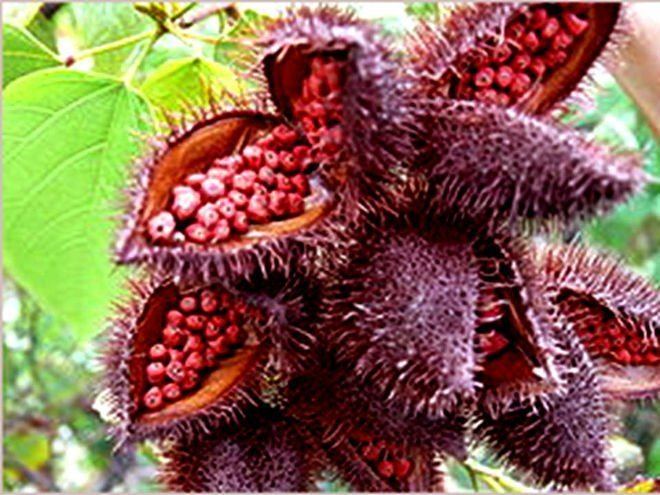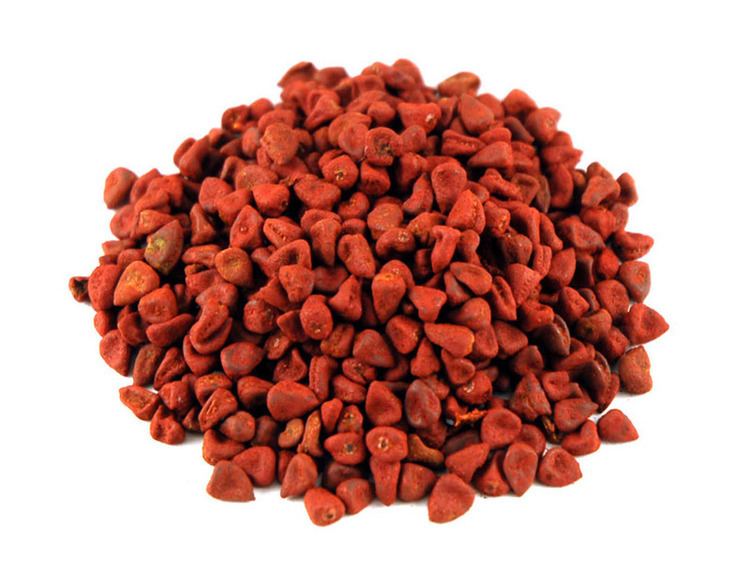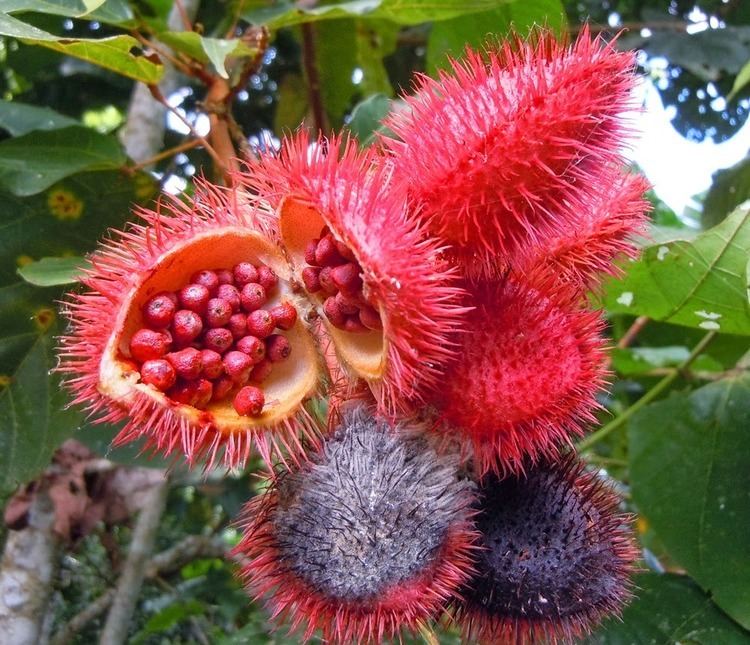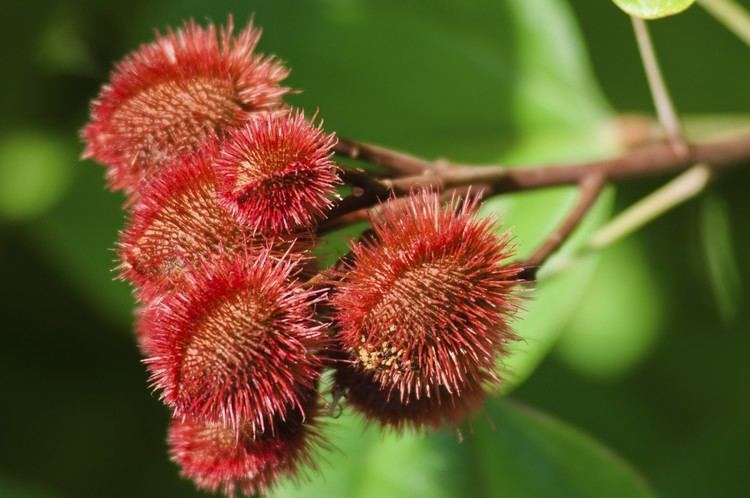 | ||
Similar Cochinita pibil, Recado rojo, Paprika, Sofrito, Adobo | ||
Chicken in annatto achiote sauce mexican food
Annatto (/əˈnætoʊ/ or /əˈnɑːtoʊ/) is an orange-red condiment and food coloring derived from the seeds of the achiote tree (Bixa orellana). It is often used to impart a yellow or orange color to foods, but sometimes also for its flavor and aroma. Its scent is described as "slightly peppery with a hint of nutmeg" and flavor as "slightly nutty, sweet and peppery".
Contents
- Chicken in annatto achiote sauce mexican food
- What is annatto how to make annatto rice recipe
- History
- Traditional cuisine
- Industrial food coloring
- Chemical composition
- Safety
- Human research
- References

The color of annatto comes from various carotenoid pigments, mainly bixin and norbixin, found in the reddish waxy coating of the seeds. The condiment is typically prepared by grinding the seeds to a powder or paste. Similar effects can be obtained by extracting some of the color and flavor principles from the seeds with hot water, oil, or lard, which are then added to the food.

Annatto and its extracts are now widely used in an artisanal or industrial scale as a coloring agent in many processed food products, such as cheeses, dairy spreads, butter and margarine, custards, cakes and other baked goods, potatoes, snack foods, breakfast cereals, smoked fish, sausages, and more. In these uses, annatto is a natural alternative to synthetic food coloring compounds, but it has been linked to cases of food-related allergies. Annatto is of particular commercial value in the United States because the Food and Drug Administration considers colorants derived from it to be "exempt of certification".

What is annatto how to make annatto rice recipe
History

The annatto tree B. orellana is believed to originate from Brazil. It was probably not initially used as a food additive, but for other purposes such as ritual and decorative body painting (still an important tradition in many Brazilian native tribes), sunscreen, and insect repellent, and for medical purposes. It was used for Mexican manuscript painting in the 16th century.

Annatto has been traditionally used as both a coloring and flavoring agent in Latin America, the Caribbean, and other countries where it was taken by Spanish and Portuguese explorers in the 16th century. It is also called by local names such as achiote, bija, roucou (Peru, French Guyana), koesoewe or kusuwe (Suriname), onoto (Venezuela), atsuete (Philippines), or colorau (Brazil). Its use has spread in historic times to other parts of the world, and it was incorporated in local culinary traditions of many countries outside the Americas.
Traditional cuisine

Ground annatto seeds, often mixed with other seeds or spices, are used in form of paste or powder for culinary use, especially in Latin American, Jamaican, Chamorro, and Filipino cuisines. Many cuisines traditionally use annatto in recipes of Spanish origin that originally call for saffron; for example, in arroz con pollo, to give the rice a yellow color. In Venezuela, annatto is used in the preparation of hallacas, perico, and other traditional dishes. Annatto seeds are also a component of some local sauces and condiments, such as recado rojo in Yucatán and sazón in Puerto Rico. Annatto paste is an important ingredient of cochinita pibil, the spicy pork dish popular in Mexico. It is also a key ingredient in the drink tascalate from Chiapas, Mexico. In the Philippines it is used for the sauce of pancit.
Industrial food coloring
Annatto is used currently to impart a yellow or orange color to many industrialized and semi-industrialized foods. In the European Union, it is identified by the E number E160b.
Annatto has been a traditional colorant for Gloucester cheese since the 16th century. During the summer, the high levels of carotene in the grass would have given the milk an orange tint which was carried through into the cheese. This orange hue came to be regarded as an indicator of the best cheese, spurring producers of inferior cheese to use annatto in order to replicate it. The custom of adding annatto then spread to other parts of the UK, for cheeses such as Chesire and Red Leicester, as well as colored cheddar made in Scotland. Many cheddars are produced in both white and red (orange) varieties, with the latter being more popular despite the only difference between the two being the presence of annatto as a coloring. That practice has extended to many modern processed cheese products, such as American cheese and Velveeta.
Chemical composition
The yellow to orange color is produced by the chemical compounds bixin and norbixin, which are classified as carotenoids. The fat-soluble color in the crude extract is called bixin, which can then be saponified into water-soluble norbixin. This dual solubility property of annatto is rare for carotenoids. The seeds contain 4.5–5.5% pigment, which consists of 70–80% bixin. Unlike beta-carotene, another well-known carotenoid, annatto-based pigments are not vitamin A precursors. The more norbixin in an annatto color, the more yellow it is; a higher level of bixin gives it a more orange shade.
Safety
In the United States, annatto extract is listed as a color additive "exempt from certification" and is informally considered to be a natural coloring. Foods colored with annatto may declare the coloring in the statement of ingredients as "colored with annatto" or "annatto color."
Annatto condiments and colorants are safe for most people when used in food amounts, but they may cause allergic reactions in those who are sensitive. In one 1978 study of 61 patients suffering from chronic hives or angioedema, 56 patients were orally provoked by annatto extract during an elimination diet. A challenge was performed with a dose equivalent to the amount used in 25 grams (0.88 oz) of butter. Twenty-six percent of the patients reacted to this color four hours after intake, worse than amaranth (9%) or synthetic dyes such as tartrazine (11%), Sunset Yellow FCF (17%), Food Red 17 (16%), Ponceau 4R (15%), erythrosine (12%) and Brilliant Blue FCF (14%).
Annatto is not among the "Big Eight" substances causing hypersensitivity reactions (cow's milk, egg, peanuts, tree nuts, fish, shellfish, soy, and wheat), which are responsible for more than 90% of allergic food reactions. The Food and Drug Administration and experts at the Food Allergy Research and Resource Program (FARRP) at the University of Nebraska do not include annatto in the list of major food allergens.
Human research
As annatto is a source of tocotrienols, such as geranylgeraniol—compounds similar in structure and function to vitamin E—its extracts were under preliminary research as of 2015 to determine their potential biological properties in humans. In one such application, annatto geranylgeraniol is an ingredient in an experimental medical food being investigated for its effect on blood lipoproteins.
